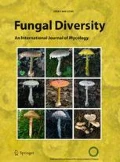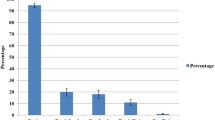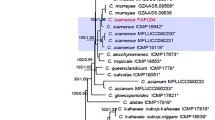Abstract
Grapevine anthracnose is an important disease, responsible for mild to severe yield losses in grape production, and is also an important post harvest disease. The disease was studied in vineyards in six provinces in China, with 34 isolates obtained from diseased grapes. Multi-gene (ACT, ITS, GAPDH, TUB2 and CHS) analysis coupled with morphology showed that Colletotrichum aenigma, C. hebeiense sp. nov. and C. viniferum were associated with grapevine anthracnose in China. Colletotrichum aenigma is reported for the first time as associated with grapevine anthracnose. Colletotrichum hebeiense is a new species introduced here. Pathogenicity testing showed that all species can infect grapes, causing anthracnose however, virulence of species and isolates showed great variation. Phylogenetic analysis showed that C. viniferum is a cryptic species and its taxonomy needs to be resolved in the future.




Similar content being viewed by others
References
Afanador-Kafuri L, Minz D, Maymon M, Freeman S (2003) Characterization of Colletotrichum isolates from tamarillo, passiflora and mango in Columbia and identification of a unique species from the genus. J Phytopathol 93:579–587
von Arx JA (1957) Die Arten der Gattung Colletotrichum Cda. Phytopathol Z 29:413–468
Cai L, Hyde KD, Taylor PWJ, Weir BS, Waller J, Abang MM, Zhang JZ, Yang YL, Phoulivong S, Liu ZY, Prihastuti H, Shivas RG, McKenzie EHC, Johnston PR (2009) A polyphasic approach for studying Colletotrichum. Fungal Divers 39:183–204
Cannon PF, Buddie AG, Bridge PD (2008) The typification of Colletotrichum gloeosporioides. Mycotaxon 104:189–204
Cannon PF, Damm U, Johnston PR, Weir BS (2012) Colletotrichum-current status and future directions. Stud Mycol 73:181–213
Carbone I, Kohn LM (1999) A method for designing primer sets for speciation studies in filamentous ascomycetes. Mycologia 91:553–556
Chomnunti P, Hongsanan S, Aguirre-Hudson B, Tian Q, Peršoh D, Dhami MK, Alias AS, Xu J-C, Liu X-Z, Stadler M, Hyde KD (2014) The sooty moulds. Fungal Divers 66:1–36
Damm U, Woudenberg JHC, Cannon PF, Crous PW (2009) Colletotrichum species with curved conidia from herbaceous hosts. Fungal Divers 39:45–87
Damm U, Cannon PF, Woudenberg JHC, Crous PW (2012) The Colletotrichum acutatum species complex. Stud Mycol 73:37–113
Daykin ME, Milholland RD (1984) Ripe rot of Muscadine grape caused by Colletotrichum gloeosporioides and its control. Phytopathology 74:710–714
Doyle VP, Oudemans PV, Rehner SA, Litt A (2013) Habitat and host indicate lineage identity in Colletotrichum gloeosporioides s.l. from wild and agricultural landscape in North America. PLoS ONE 8:1–21
Ellis MA, Erincik O (2008) Anthracnose of Grape. Agriculture and Natural Resources 1–3
Freeman S, Katan T, Shabi E (1998) Characterization of Colletotrichum species responsible for anthracnose disease of various fruits. Plant Dis 82:596–605
Gardes M, Bruns TD (1993) ITS primers with enhanced specificity for basidiomycetes – application to the identification of mycorrhizae and rusts. Mol Ecol 2:113–118
Greer LA, Harper JDI, Savocchia S, Samuelian SK, Steel CC (2011) Ripe rot of south-eastern Australian wine grapes is caused by two species of Colletotrichum: C. acutatum and C. gloeosporioides with differences in infection and fungicide sensitivity. Aust J Grape Wine Res 17:123–128
Gunjan S, Navinder K, Weir BS, Hyde KD, Shenoy BD (2013) Apmat gene can resolve Colletotrichum species: a case study with Mangifera indica. Fungal Divers 61:117–138
Hall TA (1999) BioEdit: a user-friendly biological sequence alignment editor and analysis program for windows 95/98/NT. Nucleic Acids Symp Ser 41:95–98
Hillis DM, Bull JJ (1993) An empirical test of bootstrapping as a method for assessing confidence in phylogenetic analysis. Syst Biol 42:182–192
Hyde KD, Cai L, Cannon PF, Crouch JA, Pw C, Damm U, Goodwin PH, Chen H, Johnston PR, Jones EBG, Liu ZY, McKenzie EHC, Moriwaki J, Noireung P, Pennycook SR, Pfenning LH, Prihastuti H, Sato T, Shivas RG, Tan YP, Taylor PWJ, Weir BS, Yang YL, Zhang JZ (2009a) Colletotrichum names in current use. Fungal Divers 39:147–182
Hyde KD, Cai L, McKenzie EHC, Yang YL, Zhang JZ, Prihastuti H (2009b) Colletotrichum: a catalogue of confusion. Fungal Divers 39:1–17
Hyde KD, Chomnunti P, Crous PW, Groenewald JZ, Damm U, Koko TW, Shivas RG, Summerell BA, Tan YP (2010) A case for re-inventory of Australia’s plant pathogens. Persoonia 25:50–60
Hyde KD, Nilsson RH, Alias SA, Ariyawansa HA, Blair JE, Cai L, de Cock AWAM, Dissanayake AJ, Glockling SL, Goonasekara ID, Gorczak M, Hahn M, Jayawardena RS, van Kan JAL, Laurence MH, Lévesque CA, Li XH, Liu JK, Maharachchikumbura SSN, Manamgoda DS, Martin FN, McKenzie EHC, McTaggart AR, Mortimer PE, Nair PVR, Pawłowska J, Rintoul TL, Shivas RG, Spies CFJ, Summerell BA, Taylor PWJ, Terhem RB, Udayanga D, Vaghefi N, Walther G, Wilk M, Wrzosek M, Xu JC, Yan JY, Zhou N (2014) One stop shop: backbones trees for important pytopathogenic genera: I (2014). Fungal Divers 67:21–125
Katoh K, Toh H (2008) Recent developments in the MAFFT multiple sequence alignment program. Bioinformatics 9:276–285
Kishino H, Hasegawa M (1989) Evaluation of the maximum likelihood estimate of the evolutionary tree topologies from DNA sequence data. J Mol Evol 29:170–179
Kummuang N, Diehl SV, Smith BJ, Graves CH Jr (1996) Muscadine grape berry rot disease in Mississippi: disease epidemiology and crop reduction. Plant Dis 80:244–247
Lu XL (2005) Studies on biochemistry and molecular biology of genetic diversity of grape cultivar and resistant appraisal of downey mildew. PhD thesis. Sichuan Agricultural University, Sichuan
Nylander JAA (2004) MrModeltest 2.0. Program distributed author. Evolutionary Biology Centre, Uppsala University
O’Donnell K, Cigelnik E (1997) Two divergent intra genomic rDNA ITS2 types within a monophyletic lineage of the fungus Fusarium are nonorthologous. Mol Phylogenet Evol 7:103–116
Page RDM (1996) TreeView: an application to display phylogenetic trees on personal computers. Comput Appl Biosci 12:357–358
Paull RE, Nishijima W, Reyes M, Cavaletto C (1977) A review of postharvest handling and losses during marketing of papaya (Carica papaya L.). Post Harv Biol Technol 11:165–179
Peng LJ, Sun T, Yang YL, Cai L, Hyde KD, Bahkali HA, Liu ZY (2012) Colletotrichum species on grape in Guizhou and Yuannan provinces, China. Mycoscience 54:29–41
Phoulivong S, Cai L, Chen H, McKenzie EHC, Abdelsalam K, Chukeatirote E, Hyde KD (2010) Colletotrichum gloeosporioides is not a common pathogen on tropical fruits. Fungal Divers 44:33–43
Prihastuti H, Cai L, Chen H, McKenzie EHC, Hyde KD (2009) Characterization of Colletotrichum species associated with coffee berries in northern Thailand. Fungal Divers 39:89–109
Rojas EI, Rehner SA, Samuels GJ, Van Basel SA, Herre EA, Cannon P, Chen R, Pang J, Wang R, Zhang Y, Peng YQ, Sha T (2010) Colletotrichum gloeosporioides s.l. associated with Theobroma cocoa and other plants in Panama: multilocus phylogenies distinguish host- associated pathogens from asymptomatic endophytes. Mycologia 102:1318–1338
Ronquist F, Huelsenbeck JP (2003) MrBayes 3: Bayesian phylogenetic inference under mixed models. Bioinformatics 19:1572–1574
Saccardo PA (1913) Sylloge fungorum omnium husque cognitoru. Sumptibus Auctoris 22:1199
Sangeetha CG, Rawal RD (2008) Nutritional studies of Colletotrichum gloeosporioides (Penz.) Penz. and Sacc. the incitant of mango anthracnose. World J Agric Sci 4:717–720
Shiraishi M, Koide M, Itamura H, Yamada M, Mitani N, Ueno T, Nakaune R, Nakano M (2007) Screening for resistance to ripe rot caused by Colletotrichum acutatum in grape germplasm. Vitis 46:196–200
Silva DN, Talhinas P, Várzea V, Cai L, Paulo OS, Batista D (2012) Application of the Apn2/MAT locus to improve the systematics of the Colletotrichum gloeosporioides complex: an example from coffee (Coffea spp.) hosts. Mycologia 104:396–409
Southworth EA (1891) Ripe rot of grapes and apples. J Mycol 6:64
Steel CC, Greer LA, Savocchia S, Samuelian S (2011) Effect of temperature on Botrytis cinerea, Colletotrichum acutatum and Greeneria uvicola mixed fungal infection of Vitis vinefera grape berries. Vitis 50:69–71
Sung KH, Wang GK, Hae GK, Kyung JC (2008) Morphological variation, genetic diversity and pathogenicity of Colletotrichum species causing grape ripe rot in Korea. J Plant Pathol 24:269–278
Sutton BC (1992) The genus Glomerella and its anamorph Colletotrichum. In: Jeger MJ (ed) Colletotrichum biology, pathology and control (Bailey JA. CAB International, Wallingford, pp 1–26
Suzaki K (2011) Improved method to induce sporulation of Colletotrichum gloeosporioides, causal fungus of grape ripe rot. J Gen Plant Pathol 77:81–84
Swofford DL (2002) PAUP*: phylogenetic analysis using parsimony (*and other methods). Version 4b10. Sinauer Associates., Sunderland
Templeton MD, Rikkerink EHA, Solon SL, Crowhurst RN (1992) Cloning and molecular characterization of the glyceraldehyde-3-phosphate dehydrogenase encoding gene and cDNA from the plant pathogenic fungus Glomerella cingulata. Gene 122:225–230
Than PP, Jeewon R, Hyde KD, Pongsupasamit S, Mongkolporn O, Taylor PWJ (2008) Characterization and pathogenicity of Colletotrichum species associated with anthracnose on chilli (Capsicum spp.) in Thailand. Plant Pathol 57:562–572
Thompson JD, Gibson TJ, Plewniak F, Jeanmougin F, Higgins DG (1997) The Clustsal X windows interface: flexible strategies for multiple sequence alignment aided by quality 1 analysis tools. Nucleic Acids Res 24:4876–4882
Udayanga D, Manamgoda DS, Liu XZ, Chukeatirote E, Hyde KD (2013) What are the common anthracnose pathogens of tropical fruits? Fungal Divers 61:165–179
Weir B, Johnston PR, Damm U (2012) The Colletotrichum gloeosporioides species complex. Stud Mycol 73:115–180
White TJ, Bruns T, Lee S, Taylor JW (1990) Amplification and direct sequencing of fungal ribosomal RNA genes for phylogenetics. In: Gelfand DH, Sninsky JJ, White TJ (eds) PCR protocols: a guide to methods and applications. (Innis MA. Academic, New York, pp 315–322
Whitelaw-Weckert MA, Curtin SJ, Huang R, Steel CC, Blanchard CL, Roffey PE (2007) Phylogenetic relationships and pathogenicity of Colletotrichum acutatum isolates from grape in subtropical Australia. Plant Pathol 56:448–463
Winkler AJ, Cook JA, Kliewer WM, Lider LA (1974) Grape diseases and disorders. In: General viticulture. Univ. Calif. Press. Berkeley, Los Angeles, London, pp 439–502
Acknowledgments
The study is funded by CARS-30. There are many people to thank for their assistance with this work. The authors would like to thank Miss. Qin Tian for the help given to perform the pathogenicity tests and Miss. K. W. T. Chethana for the help given in phylogenetic analysis. Authors would like to thank the grape cultivators who provided the diseased fruits. K.D. Hyde thanks the National Research Council of Thailand, Colletotrichum grant number 54201020003 and The Chinese Academy of Sciences, project number 2013T2S0030, for the award of Visiting Professorship for Senior International Scientists at Kunming Institute of Botany. This work was also supported by a grant from the National Plan of Science and Technology, King Abdulaziz City of Science and Technology, Riyadh, Saudi Arabia (10-Bio-965-02). M.M.R.S. Jayawardena would like to thank H. A. Ariyawansa, D. Udayanga for the support given.
Author information
Authors and Affiliations
Corresponding author
Rights and permissions
About this article
Cite this article
Yan, JY., Jayawardena, M.M.R.S., Goonasekara, I.D. et al. Diverse species of Colletotrichum associated with grapevine anthracnose in China. Fungal Diversity 71, 233–246 (2015). https://doi.org/10.1007/s13225-014-0310-9
Received:
Accepted:
Published:
Issue Date:
DOI: https://doi.org/10.1007/s13225-014-0310-9




